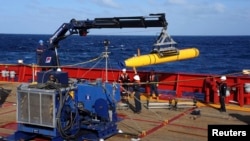A U.S. Navy underwater drone sent to search for a missing Malaysian jetliner on the floor of the Indian Ocean had its first mission cut short after exceeding its 4.5 km (2.8 mile) depth limit, Australian search authorities said on Tuesday. It had been expected to spend up to 16 hours scouring the silty sea floor, after a two-hour descent.
"It's [the drone's] built-in safety feature returned it to the surface,'' the Australian agency coordinating the search and recovery operation said. "The six hours of data gathered by the Autonomous Underwater Vehicle is currently being extracted and analyzed."
The launch of the Blue-fin 21 autonomous underwater vehicle on Monday marked a new phase in the six-week search for Malaysia Airlines MH370 which disappeared on March 8 and is presumed to have crashed thousands of kilometers off course with the loss of all 239 people on board.
Searchers are confident they know the approximate position of wreckage of the Boeing 777, some 1,550 km (963 miles) northwest of Perth, and are moving ahead on the basis of four acoustic signals they believe are from its black box recorders.
The robotic submarine was sent down nearly a week after sound-locating equipment last heard signals that are believed to be from the missing jet's black boxes.
Angus Houston, who heads Australia's Joint Agency Coordination Center, said Monday, "We haven't had a single detection in six days, so I guess it's time to go underwater."
The plane's flight recorder boxes emit signals so they can be more easily found, but their batteries only last about a month. It has been nearly 40 days since the jet went missing.
Search crews also are investigating an oil slick found in the search area. Crews have collected samples that have been sent for testing.
Australian Prime Minister Tony Abbott continues to sound notes of caution, stressing that trying to find anything nearly five kilometers below the surface of the Indian Ocean, 1,000 kilometers from land, is a huge task that will not likely end anytime soon.
The small robotic sub, called Bluefin 21, is using sonar to chart any debris in the search for the plane's flight recorders on the sea floor. Officials say it will take 24 hours to complete each mission in which the sub will chart approximately 40 square kilometers.
The Boeing 777 with 239 people on board disappeared March 8 during a scheduled flight from Kuala Lumpur to Beijing. Two-thirds of those on board were Chinese nationals.
A leading Malaysian newspaper has said investigators probing the plane's disappearance suspect the co-pilot attempted to make a cellphone call after the jetliner deviated from its original course.
The New Straits Times has said investigators believe the call ended abruptly after the phone made contact with a communications tower, as the jetliner flew at low altitude northwest of the island of Penang. The newspaper said its sources declined to reveal whom the caller was trying to reach.
Malaysian Defense Minister Hishammuddin Hussein has cast doubt on the report, telling reporters he would have been informed about such a call if it had taken place.
Some information for this report provided by Reuters.
"It's [the drone's] built-in safety feature returned it to the surface,'' the Australian agency coordinating the search and recovery operation said. "The six hours of data gathered by the Autonomous Underwater Vehicle is currently being extracted and analyzed."
The launch of the Blue-fin 21 autonomous underwater vehicle on Monday marked a new phase in the six-week search for Malaysia Airlines MH370 which disappeared on March 8 and is presumed to have crashed thousands of kilometers off course with the loss of all 239 people on board.
Searchers are confident they know the approximate position of wreckage of the Boeing 777, some 1,550 km (963 miles) northwest of Perth, and are moving ahead on the basis of four acoustic signals they believe are from its black box recorders.
The robotic submarine was sent down nearly a week after sound-locating equipment last heard signals that are believed to be from the missing jet's black boxes.
Angus Houston, who heads Australia's Joint Agency Coordination Center, said Monday, "We haven't had a single detection in six days, so I guess it's time to go underwater."
The plane's flight recorder boxes emit signals so they can be more easily found, but their batteries only last about a month. It has been nearly 40 days since the jet went missing.
Search crews also are investigating an oil slick found in the search area. Crews have collected samples that have been sent for testing.
Australian Prime Minister Tony Abbott continues to sound notes of caution, stressing that trying to find anything nearly five kilometers below the surface of the Indian Ocean, 1,000 kilometers from land, is a huge task that will not likely end anytime soon.
The small robotic sub, called Bluefin 21, is using sonar to chart any debris in the search for the plane's flight recorders on the sea floor. Officials say it will take 24 hours to complete each mission in which the sub will chart approximately 40 square kilometers.
The Boeing 777 with 239 people on board disappeared March 8 during a scheduled flight from Kuala Lumpur to Beijing. Two-thirds of those on board were Chinese nationals.
A leading Malaysian newspaper has said investigators probing the plane's disappearance suspect the co-pilot attempted to make a cellphone call after the jetliner deviated from its original course.
The New Straits Times has said investigators believe the call ended abruptly after the phone made contact with a communications tower, as the jetliner flew at low altitude northwest of the island of Penang. The newspaper said its sources declined to reveal whom the caller was trying to reach.
Malaysian Defense Minister Hishammuddin Hussein has cast doubt on the report, telling reporters he would have been informed about such a call if it had taken place.
Some information for this report provided by Reuters.








